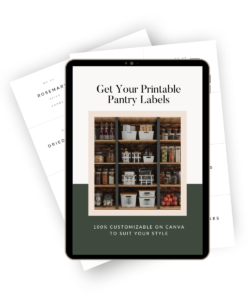There’s nothing quite like the taste of homemade jams, jellies, and fruit preserves. Whether it’s spreading tangy marmalade on toast, dolloping sweet strawberry jam onto scones, or layering rich blackberry preserves in a cake, homemade fruit spreads offer unparalleled flavor and freshness. And the best part? You can enjoy the fruits (pun intended) of your labour year-round by learning the art of canning.
If you’ve ever wondered how to make your own canned jams and preserves, you’re in the right place. This guide will take you through the process so you can learn how to make your own canned jams jellies and fruit preserves step-by-step. In no time you’ll be stocking your pantry with delicious, homemade creations to enjoy!

What’s the Difference Between Jam, Jelly, and Preserves?
Before we get started, let’s clear up the confusion:
- Jelly: Made from fruit juice, giving it a clear, smooth texture.
- Jam: Made from mashed fruit, resulting in a spreadable but slightly chunky consistency.
- Preserves: Contain larger fruit pieces or even whole fruits, suspended in a syrup or jam-like base.
Tools You’ll Need for Canning
Here’s a list of essential items for safe and effective canning:
- Canning Jars: Glass jars with two-piece lids (lid and ring).
- Water Bath Canner: A large pot with a rack to hold jars.
- Jar Lifter: For safely removing hot jars from the canner.
- Funnel: To neatly pour your jam into jars.
- Bubble Remover/Headspace Tool: To remove air bubbles and ensure proper jar filling.
- Kitchen Scale: For measuring fruit and sugar.
- Candy Thermometer: To ensure the jam reaches the right temperature for setting.
Ingredients for Homemade Jam or Jelly
The beauty of homemade preserves is their simplicity. Here’s what you’ll typically need:
- Fresh Fruit: Ripe and in-season fruit works best.
- Sugar: Acts as a preservative and enhances flavor.
- Pectin: A natural thickening agent (optional, depending on the fruit).
- Acid: Lemon juice helps with gelling and enhances flavor.
Step-by-Step Guide to Making Canned Jams, Jellies, and Preserves

1. Prepare Your Ingredients
- Wash and chop your fruit. Remove pits, stems, and any blemishes.
- Measure your fruit and sugar according to your recipe. A common ratio is 1:1 (fruit to sugar) for jam, though you can adjust based on sweetness preference.
2. Sterilize Your Jars
- Wash jars and lids in hot, soapy water.
- Place jars in a water bath canner filled with boiling water for 10 minutes. Keep them warm until ready to fill.
3. Cook Your Jam or Jelly
- Combine fruit, sugar, and pectin (if using) in a large pot.
- Heat the mixture over medium-high heat, stirring constantly to prevent burning.
- Bring to a rolling boil, then add lemon juice.
- Use a candy thermometer to check when the jam reaches 220°F (the setting point).
4. Test the Set
- Place a spoonful of the mixture on a chilled plate. Push it with your finger—if it wrinkles, it’s ready.
5. Fill Your Jars
- Use a funnel to pour the hot jam into sterilized jars, leaving about 1/4 inch of headspace.
- Wipe the rims clean with a damp cloth to ensure a proper seal.
6. Seal and Process
- Place the lids and screw on the rings until finger-tight.
- Submerge jars in the water bath canner, ensuring they’re covered by at least an inch of water.
- Boil for 10-15 minutes (processing time may vary based on altitude and recipe).
7. Cool and Store
- Remove jars using a jar lifter and let them cool on a towel for 12-24 hours.
- Check seals by pressing on the lid—if it doesn’t pop, the jar is sealed.
- Store sealed jars in a cool, dark place for up to a year.

Tips for Success
- Use Seasonal Fruits: Fresh, ripe fruit results in the best flavor.
- Adjust Sugar Carefully: Reducing sugar too much can affect the setting process.
- Experiment with Flavors: Add spices, herbs, or citrus zest for unique combinations (e.g., strawberry-basil jam or orange-cardamom marmalade).
- Label Your Jars: Include the date and type of jam for easy identification.

Why Make Your Own?
Canning your own jams, jellies, and preserves isn’t just about saving money—it’s about creating something wholesome, free from preservatives, and tailored to your taste. Plus, there’s something deeply satisfying about seeing those jars lined up on your shelf, ready to brighten breakfasts, desserts, and more.
Making your own canned jams, jellies, and fruit preserves is a rewarding experience that connects you with the timeless art of preserving food. Whether you’re a seasoned canner or a total newbie, the process is straightforward and the results are absolutely delicious.
Ready to give it a try? Start with a small batch and watch your confidence—and pantry—grow! What fruit will you preserve first? Share your ideas in the comments below!
This blog contains affiliate links, which means I may earn a small commission if you make a purchase through these links. This comes at no additional cost to you and helps support the ongoing content creation on this site. I only recommend products and services that I personally use and believe in. Thank you for your support!











 Don’t forget to grab your Free Pantry Labels! Fully editable on Canva to suit your personal design style!
Don’t forget to grab your Free Pantry Labels! Fully editable on Canva to suit your personal design style!
0 Comments